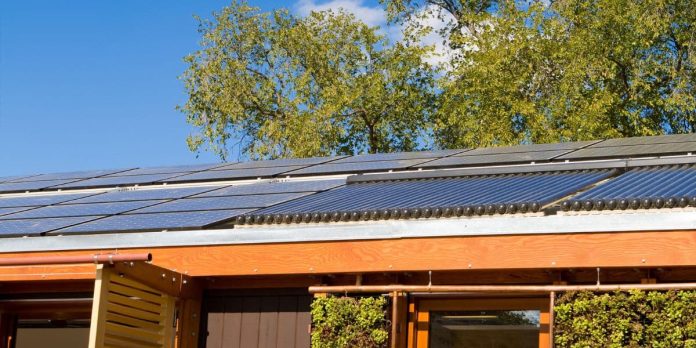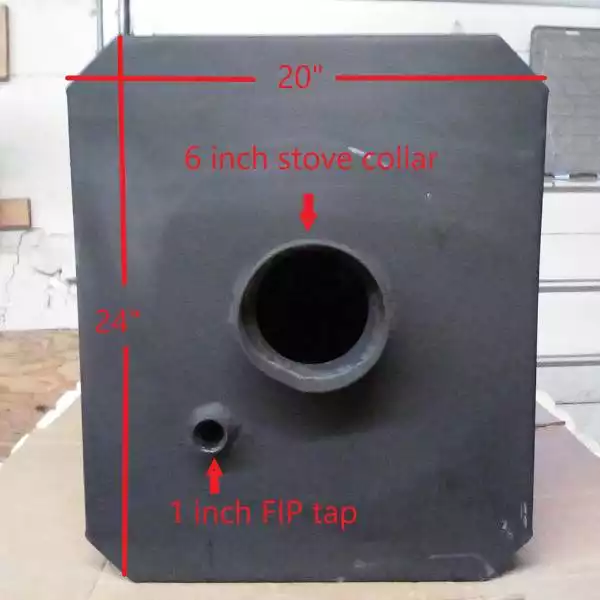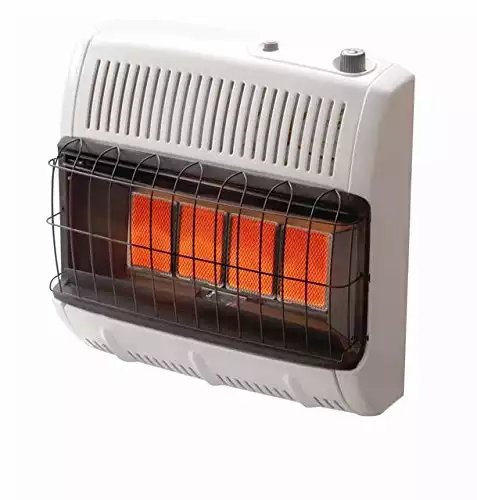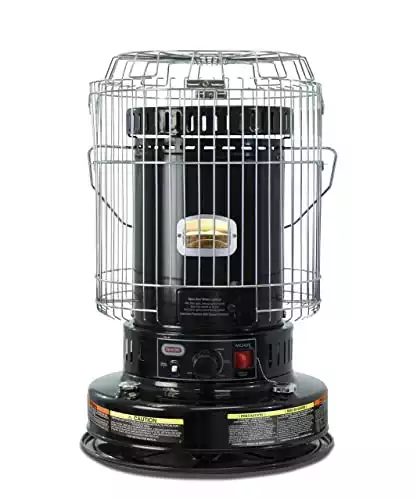Disconnecting from your local power supply is cause for celebration. However, it’s not time to break out the champagne just yet. You need to think about the future. When wintertime rolls around, staying warm will be the key to success.
The good news is there are plenty of ways to heat an off-grid living space. The optimal method for you will depend on
- Your home design
- Location
- Budget
Read on to discover 11 viable off-grid heating systems, so you can make an informed decision and stay warm no matter what.
1. Wood Stove
The humble wood stove has been around for over 400 years. Consisting of a metal box with a wood-burning fire inside, the stove has a grate to draw in oxygen and a flue running outdoors to get rid of the smoke.
Many wood stoves have space on top for cooking, doubling their efficiency.
Some people already have wood stoves installed. If you don’t have one, getting one is an investment. They generally cost from $3,000 to $3,500 for the unit and installation, but you can easily chop that price in half by installing it yourself.
So, can you really heat your home with nothing but a stove? Let’s look at the science. Heat is measured in British Thermal Units or BTUs. It takes about 3,000 BTUs to heat 100 square feet. A regular wood stove measuring four cubic feet puts out 100,000 BTUs. That’s enough to heat 3,000 square feet.
An energy-efficient stove can perform even better, but these tend to come with a heftier price tag. And then there’s the issue of heat distribution.
Even if your stove puts out 100,000 BTUs, you’ll need to get that warmth into every room. Distributing the heat efficiently will depend on the layout of your house. You might need to install a heat distribution system, which can complicate things.
Check out this convection design to learn how a wood stove can heat larger homes effectively.
Unfortunately, wood stoves generate lots of ash and require frequent cleaning. Even though there are plenty of uses for leftover wood ash, some people prefer not to deal with it. And while fuel may not be a financial burden, it can be a physical one.
Chopping, splitting, and hauling is hard work that some people may not be able to perform—and that’s assuming you have access to wood. If you live in a city or treeless area, you’ll have to buy wood and transport it. Considering the ongoing investment, a wood stove may not work in a situation like that.
Wood Stove Pros:
- Good for cooking
- Nonelectric
- Free fuel
Wood Stove Cons:
- Hard work
- Location dependent
2. Pellet Stove
Pellet stoves are similar to wood stoves but with a few key differences. Instead of using seasoned firewood as fuel, a pellet stove uses recycled pieces of leftover wood and other organic material.
The material is compressed and treated to burn more efficiently. On average, pellet stoves give off 83% of their potential efficiency. In comparison, wood stoves clock in at around 70%.
You’ll need to drop between $3,000 and $6,000 for the unit and installation. You’ll also have to keep buying pellets forever.
Different pellet types are available, and those with the lowest moisture and ash content will be more fuel efficient. However, they cost more. You can expect to pay around $1,800 per season for pellets, but costs vary widely depending on your location and home size.
Learn more about the differences between wood and pellet stoves so you can choose the one that’s right for you.
Pellet stoves require a substantial investment, but they can be much easier to work with than wood stoves. You can vent a pellet stove through the wall instead of the ceiling, making it simpler to install.
They require no chopping, splitting, hauling, or stacking. You don’t need to season wood pellets because they already contain an acceptable moisture content.
Depending on your model, pellet stoves can be a breeze to operate. You load the pellets into the feeder, and the feeder works on gravity to reload the combustion chamber as needed. Cleanup is more manageable, and the entire heating process is less hands-on.
Some pellet stoves require electricity to function, and some do not. You can buy a non-electric unit or hook an electric pellet stove up to an off-grid power source.
Pellet stoves generally won’t require much energy, but you’ll want to research the specific model you’re looking at to ensure you can power it.
Pellet Stove Pros:
- Easy to operate
- Energy efficient
- Produce little smoke
Pellet Stove Cons:
- Ongoing fuel costs
- Expensive unit
3. Propane Heater
Indoor propane heaters are relatively simple. They have a storage compartment for the fuel, an ignition mechanism, and a blower for air circulation. There are several types of propane heating systems available, including furnaces, boilers, and space heaters.
All these systems could be viable for your home depending on how much heat you need to generate and how much capital you have to invest. As you decide, consider if the unit requires power.
An off-grid home without any power source will need a propane heater with a standing pilot ignition system that doesn’t require electricity to start up.
Smaller houses may have a single propane space heater with a fuel tank attached to it. Larger homes might have furnaces or boilers, with heaters installed in each room and fuel lines running to a larger tank outside. These types of propane heating systems are popular where I live. Nearly everyone uses propane to heat their home, and the streets are lined with massive tanks as far as the eye can see.
Every winter, it’s customary for neighbors to head outdoors, gather around, and complain vehemently about the cost of propane. And they’re right. The initial price of a propane furnace can rise upwards of $12,000 for the unit and labor costs to install it, while costs per month can range from $70 to $250 for the fuel itself.
What about a single heater? This is a much more manageable option. You can buy a smaller, portable unit that’s large enough for a single room. Then, you can move it around to heat your home as needed.
If propane is your game, you need to pick your portable heater carefully. A unit like the Mr. Heater MH9BX is a solid option. This unit is large enough to heat 225 square feet and explicitly rated for indoor use. Plus, the price tag won’t set you back as much as a massive propane heating system will.
Propane Heater Pros:
- Reliable
- Powerful
- Nonelectric available
Propane Heater Cons:
- Expensive whole-house units
- Ongoing fuel cost
- Variable BTU power
4. Kerosene Heater
The great kerosene vs. propane debate rages on in the world of off-grid living. Kerosene heaters are similar to propane heaters but run on liquid kerosene. The fuel is stored in a tank and drawn out via a wick. When you light the wick, it heats the kerosene into gas and gives off heat.
Kerosene is generally more expensive than propane per fuel unit. However, kerosene burns more efficiently and can produce more BTUs per fuel unit than propane.
Bottom line? Kerosene costs more at the beginning but saves you money over time. The same cost principle applies whether you’re using a space heater, boiler, or furnace system.
Unfortunately, kerosene also has some significant drawbacks. The fuel is only guaranteed to last around 2–5 years before it goes bad, though it may last well past this point.
The tank is more difficult to refill, the unit needs regular cleaning, and you must replace the wick every so often. The constant maintenance can be irritating. Kerosene heaters can also be very dangerous, as most have an open flame.
The best kerosene heaters for indoor use will have built-in safety features to prevent fires, but you still need to be careful. Choosing one like the Dyna-Glo WK24BK will leave you resting a bit easier. It has safety features like a no-tip design, an automatic shutoff, and side-directed heat dispersion.
Kerosene Heater Pros:
- More heat
- Inexpensive units
- Fuel efficient
Kerosene Heater Cons:
- Constant maintenance
- Safety issues
5. Biomass Boiler
A biomass boiler works like a regular boiler, except it doesn’t run on gas or electricity. Instead, it runs on organic material, like wood. As the fuel burns, it heats water and circulates it through a piping system around your home. You can purchase a boiler unit for around $7,000 to $12,000.
There are many ways to set up a biomass boiler system. Most will be outside your home near the fuel source. However, smaller biomass boilers can be located inside.
Technically, both wood and pellet stoves are classified as biomass heaters already. You can convert them to boilers with the addition of water, radiators, and piping.
Check out a real-world example of how biomass boilers can heat homes and water effectively.
If you don’t have a biomass heater to convert and don’t want to shell out the dough for a new unit, you can make a biomass boiler yourself. To start with, you’ll need a firebox, piping, and a water supply. Then, you can customize your system based on your needs.
What about fuel? Everything is fair game for the boiler, including wood, sticks, corn husks, straw, and various organic trash you have lying around. It can be a lot of work to gather biomass, and you usually have to hand-feed a biomass boiler to keep it running.
However, you can’t beat biomass boilers for effectiveness and cost over time. They can operate just as efficiently as a gas or electric boiler. And if you live somewhere with lots of organic waste to gather, fuel is easy to find and doesn’t cost a thing.
Biomass Boiler Pros:
- Energy efficient
- Free fuel
- Hot water
Biomass Boiler Cons:
- Expensive units
- Labor intensive
6. Biogas Boiler
Conceptually, a biogas boiler is the same as a traditional boiler or biomass boiler. But instead of using wood or electricity as fuel, it relies on homemade biogas.
You can convert animal waste, your own waste, and food waste into biogas. So, how does it work? You generate biogas in an airtight chamber filled with organic material called a biogas digester.
Learn how to make your own biogas digester at home.
As the waste material decomposes, microbes come flocking to munch on the bio-buffet. Eventually, they begin the process of anaerobic digestion and produce methane gas. The methane gas is fed into your boiler unit via piping and used as fuel.
Biogas can also power stoves and other appliances if your systems are compatible.
However, it is not the easiest method to get right. You need a lot of poop to make it work, so only those with animals can make enough biogas for the investment to be viable.
Furthermore, it takes time and dedication to create a successful biogas system. Not many people use this method for home heating, so costs and available help can vary wildly from region to region.
Biogas Boiler Pros:
- Free fuel
- Can use for cooking
- Can power other appliances
Biogas Boiler Cons:
- Difficult to achieve
- Dealing with poop
7. Biomass Degradation
Don’t want to deal with any boiler system? You can still put your pile of biomass to good use. Biomass is organic, and all organic materials degrade over time. When they rot, thermophilic bacteria come to feast. These bacteria produce heat energy as they chow down. The energy they give off can bring surrounding temperatures up to 150 degrees Fahrenheit.
It may sound crazy, but this process is all around you. Think of steaming piles of manure, garbage, and other organic matter. All that wasted energy could be heating your house. Of course, the amount of heat you can extract from your personal biomass will depend on your system, materials, climate, and conditions.
Relying on biomass degradation requires you to run piping through the organic matter and into your home. The biomass heats water inside the pipes, providing warm water and radiant heat.
In theory, you can use it for whole-house heating. However, I’ve never heard of anyone doing this successfully. Degrading biomass doesn’t get incredibly hot, and distributing it throughout the house would lower its heat potential even further.
Check out this compost heat system to learn more about the possibilities of your degrading biomass.
It’s important to note that you need a lot of raw materials to generate higher temperatures. And even with a huge amount of biomass, the system isn’t that efficient. It can warm water but won’t get hot enough to boil it.
The process will become even less efficient during the winter. With that in mind, biomass degradation is more suitable for milder climates. And even then, it’s best to use this in conjunction with another off-grid heating solution.
Biomass Degradation Pros:
- Free fuel
- Cheap start-up
- Easy to install
Biomass Degradation Cons:
- Doesn’t get that warm
- Big pile of biomass next to your house
8. Passive Solar Home Design
Not interested in hoarding biomass? A passive solar heating design might be better for you. This system relies on strategic design features to attract and retain heat from the sun, and it can work wonders to increase the temperature inside your home. Large windows, sunrooms, and even landscaping can contribute to passive solar energy.
Discover the basics of passive solar design.
Building materials in a passive solar home must have a high thermal mass to trap, retain, and redistribute the sun’s heat effectively. Things like adobe, brick, and concrete are common in solar homes because they all have a fairly decent thermal mass and can improve the system’s functionality.
Of course, it’s not practical to build an entirely new house just so you can get that sweet sun energy. Luckily, you can incorporate passive solar features into an existing home. This can be as simple as installing some new shutters to trap heat, or it can be as involved as adding a sunroom.
Passive solar systems won’t work without energy from the sun, so those residing in cloudy climes should have a backup plan in place. And unless you’re building a passive solar home from the ground up, there’s no way to incorporate every design aspect.
With this in mind, it may be best to use this system along with another off-grid heating solution.
Passive Solar Pros:
- Little maintenance
- Free heat
- Cool architecture
Passive Solar Cons:
- Location dependent
- Cannot fully integrate retroactively
9. Active Solar Heater
An active solar heating system uses solar panels to retain heat from the sun, distributing it through the house via a piping system. These systems can supply you with hot water or heat the air inside your home. They rely on mechanical and electric components to function, but you can still use one off grid with your solar power setup.
An active solar heating system can be highly efficient. They do not require any built-in architectural design elements, so it’s easier to add them retroactively. Some systems come with automatic temperature controls that are easy to use and can substantially improve your quality of life.
However, it’s not all rainbows and sunshine. The cost of active solar heating systems can render them impractical for many people.
Even though it will pay for itself within 7–10 years, a solar space-heating system can range from $3,000 to $10,000. That’s a pretty penny.
A solar water heater can cost between $1,500 and $3,000. Furthermore, these systems still rely on fickle sunlight. If the sun disappears for a while, you’re out of luck.
It’s worth noting that active solar heating systems vary significantly in design and components. Some are simple, and some are pretty complicated. If you want to install one, it’s best to search locally for an expert in your area. Prices and availability will differ depending on your region.
Active Solar Pros:
- Free fuel
- Can heat water and air
- Easy to install retroactively
Active Solar Cons:
- Expensive
- Requires electricity
10. Heat Pumps
A regular HVAC system operates with combustion and forced-air distribution. A heat-pump system doesn’t use combustion at all. Instead, it takes warm air from one place and pumps it into another. There are two main types of heat pumps, and both can heat the entire home efficiently.
Air-source heat pumps use refrigerant to collect and store heat from the air around them.
What if it’s really cold? No problem. The refrigerant inside the coil can still trap residual heat, even though you might not be able to feel any warmth outside. As the pump compresses the air, it generates even more heat.
Air-source heat pumps can remain functional in temperatures well below freezing, and some people are happy to report that they work even at -20° F.
Check out this video to learn about heat pump technology and how it saves energy.
Geothermal or ground-source heat pumps work on the same principle as air-source heat pumps, except they collect heat from below the ground.
They are more complicated to install than air-source pumps because they require digging below the frostline. However, they provide a more stable and efficient energy source. Because the ground remains at a more constant temperature than the air year-round, geothermal pumps don’t need to work as hard.
Both types of heat pumps can provide cooling in the summer months by reversing their system, extracting warm air from your home, and depositing it outside. Heat pumps are widely considered one of the most energy-efficient ways to heat a home. They give off over three times the amount of heat energy that they require in terms of electricity.
Speaking of electricity, off-grid homeowners will need to figure out a power source for their pump. You can use a generator, solar panels, a wind turbine, or a wind-solar hybrid system.
You’ll also need to factor in the cost of a heat-pump system, as they don’t come cheap. Depending on the type, efficiency rating, and heating capacity, a heat pump can cost anywhere from $3,500 to $10,000.
Heat Pump Pros:
- Works in any climate
- Energy efficient
- Stable heat year-round
Heat Pump Cons:
- Expensive
- Requires electricity
11. Fireplace
While a fireplace can be a viable emergency heating option, it won’t work well for regular long-term use.
Since most of the heat escapes through the chimney, a fireplace just can’t heat your home that efficiently. That said, many people already have fireplaces and can’t afford to install something different. Instead of shivering all winter long, you can work with what you have to improve it.
Adding a glass door to your fireplace can maximize its heat output by preventing warm air from being sucked out of the room. You can also install a heat exchange, fireplace fan, or blower insert to help circulate hot air into other parts of your home. Seal up any cracks with a liberal dose of caulk, and close the flue when the fire goes out to prevent heat from escaping.
Placing a flat metal fireback at the back of the fireplace will also increase warmth. The fireback reflects heat out toward your house as the fire burns, helping to boost the temperature inside. Make sure to burn good-quality seasoned firewood and clean your chimney often to increase your unit’s energy efficiency.
Fireplace Pros:
- Already there
- Free fuel
- Can use for cooking
Fireplace Cons:
- Inefficient
- Constant maintenance











